Japanese Expanded Cinema Revisited
Aug. 15—Oct. 15, 2017
- Aug. 15—Oct. 15, 2017
- Closed Monday(if Monday is a national holiday or a substitute holiday, it is the next day)
- Admission:Adults ¥600/College Students ¥500/High School and Junior High School Students, Over 65 ¥400
Tokyo Photographic Art Museum is pleased to announce the exhibition “Japanese Expanded Cinema Revisited”.
Centered around the museum’s collection, this exhibition will concentrate on works that employ methods or forms other than conventional movie theater projection to consider the ‘Expanded Cinema’ concept that was developed from the mid-sixties onwards by artists and experimental filmmakers based largely in Europe and the U.S.A. Japan was quick to carry out experiments in ‘Expanded Cinema’ from around the 1960s, and we will focus on Japanese film history to reconsider its uniqueness and foresight. The results of this trend are now familiar to us all through multi-projection, loop projection and live performances, but it also responded to the intermedia or art and technology that flourished during the same period, rediscovering the diversity that always existed in film. More than fifty years have now passed since the birth of this movement and we hope that by re-exploring
‘Expanded Cinema’ we will be able to trace the transition and contemporariness of imagery from the earliest times up to the present day.
Artists:
MATSUMOTO Toshio, Shūzō AZUCHI Gulliver, IIMURA Takahiko, OE Masanori, MANABE Hiroshi, JONOUCHI Motoharu, SASAKI Michiko, KANESAKA Kenji, JUD Yalkut
MATSUMOTO Toshio
Born in Nagoya, Aichi prefecture in 1932, died in 2017. Film director, filmmaker, and film theorist. After graduating from the University of Tokyo, Matsumoto began working at Shinriken Eiga, directing Ginrin (Bicycle in Dream, 1956) in collaboration with Jikken Kōbō (Experimental Workshop) members. Having been active as a theorist, writing for several magazines, such as Kiroku eiga (Documentary Film) and Eiga hihyo (Film Critics), Matsumoto then turned his focus to avant-garde documentaries with Anpo Jōyaku (1959), The Weavers of Nishijin (1961) and The Song of Stone (1963). In 1968, he founded his own production company and directed his first commercial film, Bara no sōretsu (Funeral Parade of Roses, 1969) in collaboration with ATG (Artist Theater Guild). With this film, he began making films for theatrical release, going on to direct Shura (Demons, 1971), War at the Age of Sixteen (1973), and Dogra Magra (1988). He has also directed numerous cutting-edge experimental films including For my Crushed Right Eye (1968), Expansion (1972), and Atman (1975). In Cross Talk/Intermedia, held at the Yoyogi National Gymnasium in 1969, Matsumoto made Projection for an Icon, which was screened on 20 giant balloons, and presented the huge multi-projection video work Space Projection 'Ako' in the Textile Pavilion at the 1970 Japan World Exposition in Osaka. Also known as a film theorist, his major works in this field include Eizō no Hakken (Discovery of the Image, 1963), Eiga no Henkaku (Revolution in cinema, 1972), and Eizō no Tankyū (Quest of Film, 1991).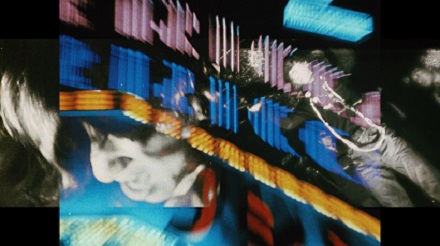
Matsumoto Toshio, For the Damaged Right Eye 1968 Single-channel video, transferred from three 16mm color films, B&W, part colour, sound, 13 min.
A masterpiece of Japanese expanded cinema which incorporates a wide range of cultural phenomena and current events, such as hippie movements, student protests and the Kwon Hyi-ro affair. Projected using three projectors, this multi-projection work oscillates between documentary footage and the avant-garde.
Shūzō AZUCH Gulliver
Born in 1947 in Ōtsu, Shiga prefecture, lives in Tokyo. Shūzō Azuchi Gulliver is an artist working across many media, including sculpture, print, photography, performance, and installation. As a high school student, he was struck by Marcel Duchamp’s writings, which prompted him to stage happenings in public gardens and on the street. Gulliver began his career by founding the happening collective Play in 1967 with Ikemizu Keiichi and Mizukami Jun in the Kansai region. He moved his base to Tokyo in the same year, developing various activities to explore his concerns through the medium of moving image, including Switch (1967) and Flying Focus (1969), before presenting Cinematic Illumination at Intermedia Art Festival in 1969. In 1973, he published his first photo book, Second Life of Gulliver. Since the 1990s, his works have been frequently shown in the Netherlands, Italy, Germany and elsewhere. His retrospective "EX-SIGN" was held at Shiga Prefectural Museum of Modern Art in 2010.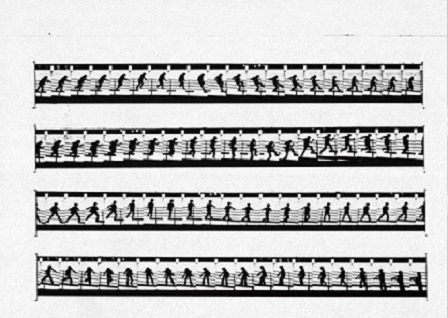
Shūzō Azuchi Gulliver, Cinematic Illumination 1968-69 Intermedia work 1440 slide films, 18 slide projectors, B&W, colour, sound (only for this exhibition)
Cinematic Illumination was screened at the Ginza discotheque ‘Killer Joe’s during Intermedia Art Festival, 1969. In this exhibition, the work, for which frames of a 16mm film strip were separated and projected them a sequence of individual slides using eighteen slide projectors to realize a 360-degree projection, will be reconstructed for the first time in approximately fifty years.
IIMURA Takahiko
Born in Tokyo in 1937. After graduating from the law department at Keio University in 1959, he began making experimental films. With the help of figures such as performance artist Ono Yōko, the painter Akasegawa Genpei, the composer Kosugi Takehisa, and the Butoh dancer Hijikata Tatsumi, Iimura produced his own 8mm and 16mm avant-garde films. Forming the “Film Independents”, an experimental film group, in 1964, he organized the first independent, experimental film festival in Japanese history. His 1965 film AI (Love) was highly acclaimed by Jonas Mekas, a leading light in New York’s experimental film scene. In 1969, Iimura shifted to video art, holding solo shows and performances at the Museum of Modern Art, New York in 1974 and the Whitney Museum in 1979, and gaining an international reputation as a video artist. Among his most notable works are Observer/ Observed (1975), AIUEONN SIX FEATURES (1993), and Seeing/Hearing/Speaking (2001). He has also published many books, including Geijutsu to hi-geijutsu no aida (Between Art and Non-Art, 1970, San-ichi Publishing, 1970), and Eizō jikken no tame ni (For Visual Experimentation, Seidosha, 1986).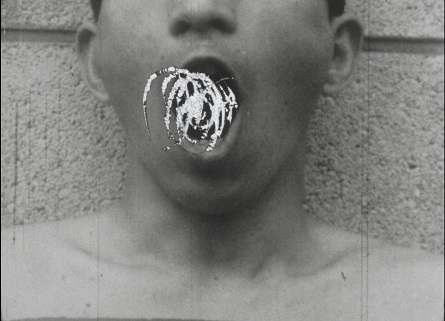
Iimura Takahiko, A Dance Party in the Kingdom of Lilliput 1964 / 1966 Double projection, 16mm film, B&W, sound, 12 min., Collection of the artist
The film is composed of a fragmentary combination of moving images documenting ordinary actions executed by Kazakura Sho, known for the performances with the NeoDadaism Organizers that abused the self/body. The present exhibition is the first occasion that this double-projection concept, with an overexposed print scratched by nails and knives, has been realised in Japan.
ŌE Masanori
Filmmaker/writer. Born 1942 in Tokushima prefecture, lives in Yamanashi prefecture. Moved to New York in 1965 and began filmmaking under the influence of underground filmmakers such as Jonas Mekas. Experienced the “psychedelic revolution” then taking place in the U.S. through his association with such figures as Timothy Leary and Richard Alpert. Produced a series of social documentaries alongside numerous works best described as the visualization of personal inner visions arising from psychedelic experiences. Head Game (1967) and No Game (1967) were later distributed throughout the U.S. by Newsreel. Great Society (1967), a six-screen projection piece commissioned by CBS, collaged newsreel footage from the U.S. at the time into an environmental work that combined a social message with powerful mental images. Returned to Japan in 1969 and established Newsreel Japan together with Kanesaka Kenji and Nakahira Takuma while also screening his own works. Since 1970 his activities have extended beyond film to include the publication of photobooks, essays on spiritualism, and other works, and numerous translations, including the Tibetan Book of the Dead (1974).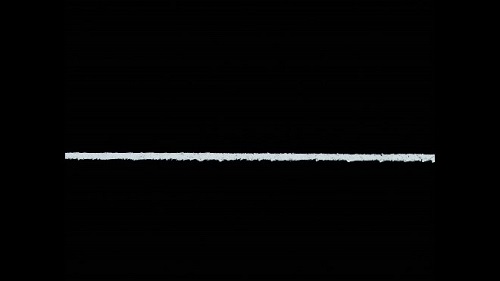
Ōe Masanori, Loop Siki No.1 / No.2 / No.3 1966 Film installation, 16mm film, B&W, sound, loop Collection of the artist
MANABE Hiroshi
Born in Uma-gun (now Niihama-shi), Ehime prefecture in 1932; died in 2000. Illustrator, animator and essayist. While studying oil painting at Tama Art University, Manabe began to exhibit in the Yomiuri Andepandan (Indépendents) and other group shows. He subsequently formed the collective Jitsuzon-sha (Existentialists) with Ikeda Masuo and others, and contributed to newspapers, magazines and sci-fi novels as a professional illustrator. Through his participation in Myūjikaru Purojekushon ‘Boku wa Kamisama’ (Musical Projection: ‘I Am God’, 1960), produced for ‘Sōgetsu Kontenporarī Shirīzu 1: Sakkyoku-ka Shūdan, Hayashi Hikaru’ (Sōgetsu Contemporary Series 1: The Composers Group, Hayashi Hikaru), and the work Shine Karikachua (Cine-Caricature, 1960), which was presented as an ‘amalgamation of moving image and jazz’ at ‘Sōgetsu Myujikku In 5: Modan Jazu no Takaku-teki Ōyō’ (Sōgetsu Music Inn 5: Multi-Angle Applications of Modern Jazz), he began interdisciplinary experiments combining moving image and other modes of expression. Manabe formed ‘Animēshon Sannin no Kai (Three-Person Animation Circle)’ with Kuri Yōji and Yanagihara Ryōhei, and at the fifth ‘Sōgetsu Kontenporarī Shirīzu’, entitled ‘Sannin no Animēshon’ (Three- Person Animation), presented Marin Sunō (Marine Snow, 1960), a fusion of projected animation, Noh stage performance, and lighting. This was followed by Shine-Poemu Sakuhin No.1 (Ciné-poem Opus No.1, 1961), Jikan (Time) and March (both 1963), Sensuikan Kashiopea (Submarine Cassiopeia, 1964) and other works. His numerous publications include Dōbutsuen (Zoo, 1959), Manabe Hiroshi no Tori no Me (Manabe Hiroshi’s Bird Eye, 1968), and Manabe Hiroshi Original 1975 (1975).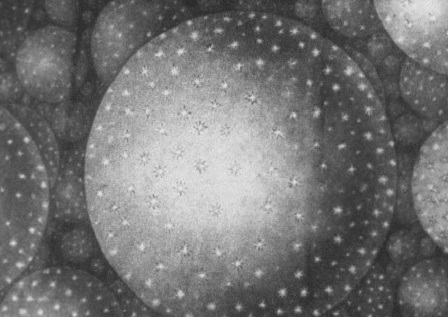
Manabe Hiroshi, Marine Snow 1960 Single-channel video, transferred from a 16mm film, B&W, sound, 22 min. Collection of The Museum of Art, EHIME
JŌNOUCHI Motoharu
Born in Ibaraki prefecture in 1935; died in 1986. Film director. Jōnouchi cofounded the Cinema Club in the College of Art at Nihon University (Nichidai Eiken) in 1957, directing N no kiroku (Document of N, 1959), and PuPu (1960). In 1961, he cofounded the VAN Film Science Research Center as a place where artists could engage in cross-disciplinary collaborations. This led to collaborations such as Document 6. 15 (1961), Shelter Plan (1964), WOLS (1964-69), Gewaltopia Trailer (1969), and Shinjuku Station (1974), with various avant-garde artists including Arakawa Shūsaku, Kazakura Shō, Akasegawa Genpei, Tone Yasunao, and Kosugi Takehisa.. From 1970 onwards, he produced numerous newsreels in conjunction with the Kanagawa Film and Newsreel Association and the Tokyo Film Association. Jōnouchi's monumental work Ainu moshiri e no mich (The Road to Ainu Mosir), which he began in 1977, was never completed.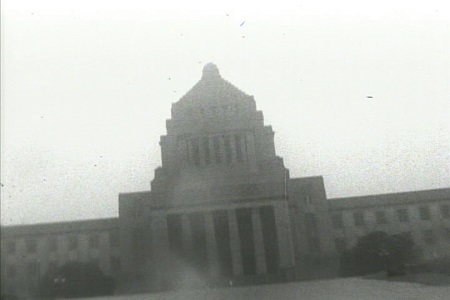
Jōnouchi Motoharu Document 6.15 1961 Single-channel video, transferred from a 16mm film, B&W, silent, 18 min.
SASAKI Michiko
Born in Nemuro, Hokkaidō in 1934, lives in Tokyo. After running an oden (Japanese traditional pot stew) street stand in Shinjuku at the age of 22, Sasaki worked in the editing department of the Nikkatsu Studio for three years, then studied photography at Tokyo College of Photography. She shot student activism organized by the Nihon University All Campus Joint Struggle Committee and stills for commercial films while also running a series of bars in the Shinjuku district, including ‘Bar Musasabi’ in Golden Gai and (Golden Gate) in Kabukichō. In 1974, she completed her film, To Die Sometime, which combined still images of activism with private footage. In 1979, she relocated to Brazil, where she managed various restaurants and inns, before moving to São Paulo in 1988 to found a private library. Sasaki returned in Japan in 1993. Her publications include Shinjuku Hatsu Amazon Yuki (From Shinjuku to Amazon, Bungei Shunjū, 1994), an autobiography, and Nichidai Zenkyōtō (Rokusaisha, 2009), a book of collected photographs.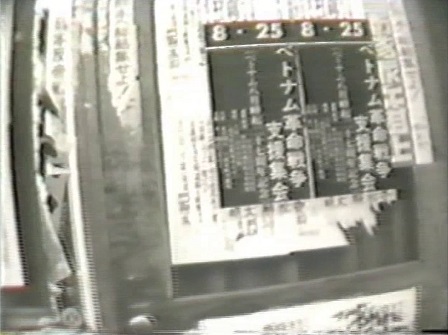
Sasaki Michiko, To Die Sometime 1974 Single-channel video, transferred from a 16mm film, B&W, sound, 30 min.
Collection of the artist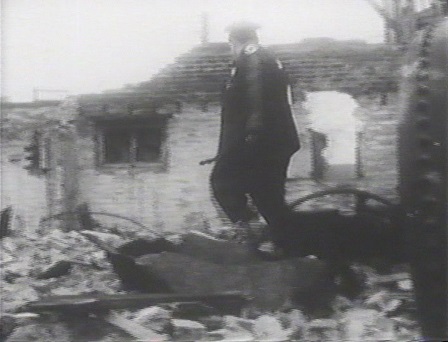
Kanesaka Kenji, Hopscotch 1967 Single-channel video, transferred from a 16mm film, B&W, sound, 10 min. Collection of the Harvard Film Archive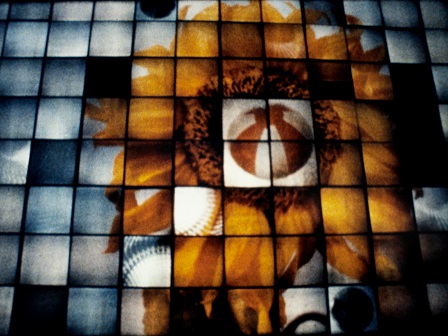
Jud Yalkut, EXPO ’67 (excerpt from ‘METAMEDIA’) 1967 Single-channel video, transferred from a 16mm film, colour, sound, 4 min. Collection of Anthology Film Archives Thanks to the Estate of Jud Yalkut
Courtesy of the Estate of Jud Yalkut and Anthology Film Archives, New York
□Sponsored by Toppan Printing Co., Ltd.
Events
- Artist Talks (in Japanese)
-
Aug. 19
(Sat)
14:00~15:30 Iimura Takahiko
Aug. 20 (Sun) 14:00~15:30 Ōe Masanori
Aug. 26 (Sat) 14:00~15:30 Shūzō Azuchi Gulliver
- The Yebisu International Festival for Art and Alternative Visions 2018, International Symposium
-
Oct. 9
(Mon)
14:00~17:00 (open 13:45)
Monday, October 9, 2017, 2 to 5 pm (open 1:45), Tokyo Photographic Art Museum, 1F Hall
Free. Limit 190 people; tickets will be distributed from 10 am on the day of the symposium at the 1F ticket counter. - Gallery Talks (in Japanese)
-
Aug. 25
(Fri)
16:00~
Sep. 8 (Fri) 16:00~
Sep. 22 (Fri) 16:00~
Oct. 13 (Fri) 16:00~


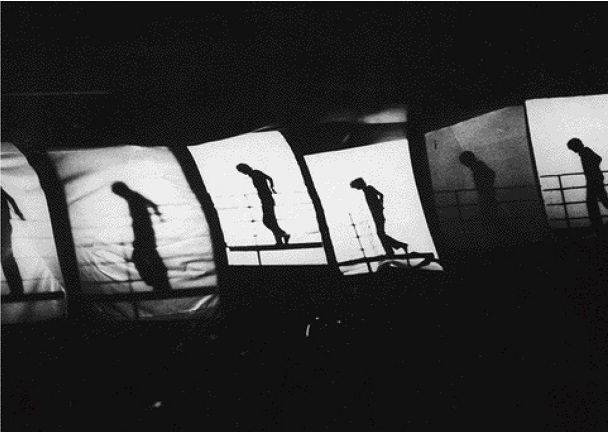
![チラシ1[pdf]](http://topmuseum.jp/upload/4/2846/thums/expanded.png)
![出品作品リスト1[pdf]](http://topmuseum.jp/upload/4/2846/thums/Expanded_works.png)